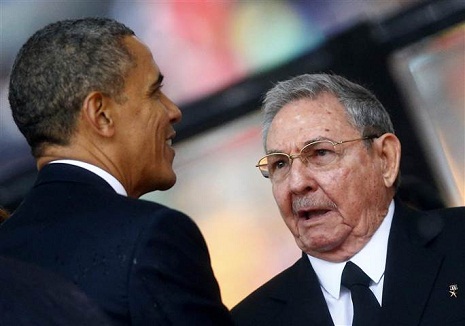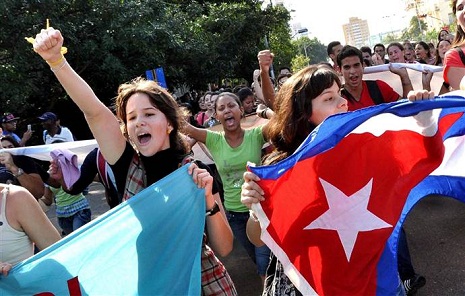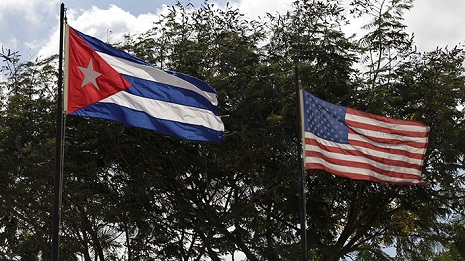An almost total embargo on Cuba was imposed by the U.S. a year later, with Kennedy stepping up partial sanctions initiated in 1960 and banning all trade with the island. The next year, financial transactions and travel by Americans were barred, too.
Political troubles then reached high alert when the U.S. learned the Soviet Union was building a missile base — capable of housing nuclear warheads — in Cuba, triggering the 13-day Cuban Missile Crisis in 1962. Many historians believe the crisis almost brought the U.S. and Soviet Union to nuclear conflict.

1965: Fidel Castro, Cuban statesman and revolutionary, who took control of Cuba in 1959 and established a Communist dictatorship, speaking at the farewell ceremony for the Centenary Youth Movement in Cuba.
As the political and economic relationships worsened, the U.S. had to tackle another issue: Cuban refugees.
The government enacted a series of laws from 1966 to 1994 on how Cuban refugees would be treated, the last one culminating in what was known as the "wet foot, dry foot" policy - meaning those who reached land could stay, while those picked up at sea were sent home. The largest number of such refugees at one time came during the 1980 Mariel boatlift, when Castro said those who wanted to leave Cuba were free to do so — and some 125,000 Cubans did.
One of the most notable refugees in later years was Elian Gonzalez, a 6-year-old Cuban boy whose mother died at sea on their way over in 1999 and who became the center of an international custody dispute that highlighted the contentious refugee policy as well as the difficult relationship between the two countries. He was eventually returned to Cuba to live with his father.
Meanwhile, Congress tightened the U.S. embargo even further with passage of the Helms-Burton Act in 1996 after two planes carrying four people belonging to the Miami-based Cuban exile group, Brothers to the Rescue, were shot down by Cuban fighters. The exile group said it had been planning to search the waters for refugees; Cuba said it had previously issued clear guidance that aircraft or vessels violating its territorial space would be shot down or sunk.
The work of spies for both sides - also emerged in the mid- to late 1990s. In 1994, an unnamed U.S. spy, of Cuban descent, began nearly 20 years of detention in Cuba. Prior to that, his work was instrumental in disrupting the Cuban Five, who were arrested in 1998 and accused of belonging to a spy cabal called the Wasp Network that had infiltrated anti-Castro exile groups in Florida. They were convicted in 2001 (Two of the five were released in 2012; the other three were released on Wednesday).
Years later, Cuba watchers saw an opening when an ill Fidel Castro passed the reins over to his brother, Raul, who took over as president in 2008. Raul Castro and U.S. President Barack Obama shared a handshake at the 2013 funeral of Nelson Mandela — a photo that spread around the globe as a sign of warming ties.

U.S. President Barack Obama (L) greets Cuba`s President Raul Castro before giving his speech at the memorial service for late South African President Nelson Mandela in Johannesburg in this December 10, 2013 file photo.
Fidel praised his brother for the gesture, coming about a month after Obama said perhaps it was time to revisit U.S. policies toward the island, but troubles remained between the two sides — specifically over the arrest of Alan Gross, who was working as a contractor for the U.S. Agency for International Development when he was detained in 2009.
Gross` family has said he was working to expand Internet access for Cuba`s small Jewish community, but Raul Castro called him a spy. Gross was sentenced in 2011 to 15 years in prison for undermining the island nation.
The future looked bleak for Gross, who had long complained of the harsh conditions of his imprisonment and had warned on the fifth anniversary of his detention in early December that he would "not endure another year" in Cuba.
But the U.S.-Cuba thaw had - at that point - already been underway for 18 months: Talks between the two sides, hosted by Canada, began in mid-2013.
One of the key players to the détente was halfway across the globe: Pope Francis. Obama met with the pope in March, when the president said Cuba was greatly discussed. The pope had written letters to Obama and Castro on resolving humanitarian issues, including that of Gross, the Vatican said Wednesday.
A similar account was given by the White House, which also revealed that in the fall the Vatican had hosted an "important meeting," where the exchange and transfer of prisoners (the American spy for the three remaining in the U.S. of the Cuban Five) was finalized, and the normalizing of relations, including diplomatic, were reviewed.
Then on Wednesday, a flood of announcements was made by Obama and the White House heralding a new era of relations with Cuba: The president`s plans on the island nation, the exchange of spies, and the release of Gross, 65, who flew home with his wife and called his daughters and sister from the plane to tell them he was free.
"Today is the first day of Hanukkah," Gross said, "and I guess so far it`s the best Hanukkah that I`ll be celebrating for a long time."

Cuban students march in a street of Havana, on Dec. 17, after Washington released three Cuban spies -- heroes in Cuba-- who had been in a US prison since 2001. The United States and Cuba brought their bitter Cold War stand-off towards a historic close Wednesday, agreeing to revive diplomatic ties and to ease a five-decade US trade embargo.
There had been other - public - signs in recent months of a warming between the two countries. Obama and Castro are slated to attend a summit in Panama in April, the first to include both leaders, and Secretary of State John Kerry has praised Cuba`s efforts to fight Ebola.
Investors, companies and many U.S. states that have long looked to do business are hopeful about the changes. Many state lawmakers and Congressional representatives have visited the island in recent years, notably those from the Midwest looking to strike commodity deals. Cuba last year said the consequences of the embargo had amounted to $1.1 trillion in losses for the island; estimates of the impact on the U.S. are from $1.2 billion to $3.6 billion. Others hoping to benefit are Cuban cigar makers and Major League Baseball.
President Raul Castro went on Cuban television on Wednesday to welcome the restored relationship. He said there remained profound disagreements, including on human rights, but that the two countries must live with their differences "in a civilized manner."
From the White House, Obama declared that the U.S. was ending an "outdated approach" after five decades of isolation failed to accomplish the goal of a democratic and prosperous Cuba and said it was "time for a new" way.
"Neither the American nor the Cuban people are well-served by a rigid policy that`s rooted in events that took place before most of us were born," he said.
















































